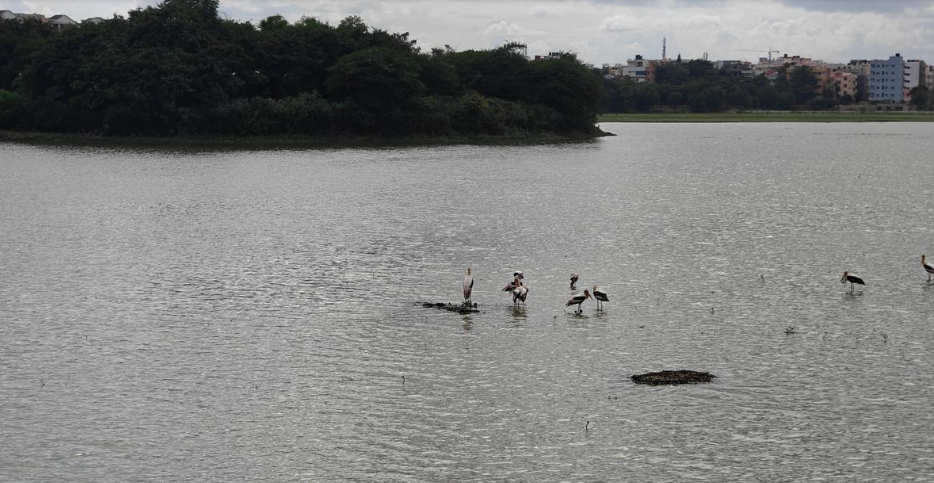The Complex Process of Restoring Lakes in Bengaluru (GS Paper 3, Environment)

Context
- As policymakers in Bengaluru initiate lake restoration efforts, there is a growing concern about setting unrealistic expectations regarding the quality of water that can be achieved.
- A recent report by the Karnataka State Pollution Control Board (KSPCB) highlights the challenges ahead, revealing that none of the 110 lakes studied in the city meet potable water quality standards.
Understanding Potable Water
- Potable water is defined as water that is safe for human consumption, suitable for drinking and cooking.
- It must be free from toxins, carcinogens, pathogenic microorganisms, and other health hazards.
Achieving Potable Water Quality in Lakes
To meet the highest quality standards for potable water, lakes must overcome significant hurdles:
- Purity of Rainwater: Rainwater is often considered the purest form of water; however, once it interacts with the atmosphere, it becomes contaminated.
- Pollutants from Surfaces: As rainwater moves across urban surfaces, it picks up various minerals, chemicals, and pollutants, further degrading its quality.
- Runoff Challenges: Even with measures in place to prevent wastewater from entering the lakes, the water quality may still fall short of potable standards due to runoff.
- Biochemical Processes: The stagnant nature of lake water can lead to biochemical processes that further compromise quality.
Sources of Water in Bengaluru Lakes
Lakes in Bengaluru receive water from three primary sources:
- Treated/Partially Treated Wastewater: Inflows from sewage treatment plants.
- Rainwater Mixed with Sewage: Known as combined sewer overflows (CSOs), these occur via stormwater drains.
- Raw Sewage: Often enters lakes through open stormwater drains.
Given this context, expecting potable water quality in these lakes is unrealistic.
Cost of Reducing Pollutants
The financial implications of improving water quality are significant:
- High Treatment Costs: Treating 1 million liters of wastewater to meet secondary treatment standards can cost approximately ₹1 crore, alongside ongoing operational and maintenance expenses.
- Infrastructure Focus: Many restoration projects center around installing sewage treatment plants and channeling treated effluent into constructed wetlands.
- CSO Management: During the rainy season, excess water from CSOs is diverted into lakes via management channels, and sedimentation ponds are built near CSO outlets to enhance water quality.
KSPCB Study Results
The KSPCB study found that all 110 lakes fell into:
- Category D: Suitable for wildlife propagation and fisheries.
- Category E: Suitable for irrigation and industrial cooling but unfit for human use.
None of the lakes met the standards for swimming (Category B) or potable water (Categories A and C).
Biological Oxygen Demand (BOD) and Water Quality
A key metric in assessing lake quality is Biological Oxygen Demand (BOD).
- BOD Levels: For a lake to move from Category E or D to C, the BOD must be reduced to 3 mg/l.
- Misleading Metrics: A reduction from 30 mg/l to 15 mg/l may still categorize a lake as D or E, suggesting no progress despite improvements.
- Lack of Standards: The absence of ambient standards for nutrients like nitrogen limits the evaluation of interventions’ impacts on water quality.
Way Forward
To ensure effective restoration, it is crucial to set realistic expectations:
- Identify the Problem: Understand the specific challenges facing each lake.
- Prioritize Issues: Engage stakeholders to determine the most pressing concerns.
- Baseline Assessments: Conduct thorough evaluations to clarify challenges.
- Estimate Improvements: Based on available funds, assess what levels of improvement are feasible.
- Sustainable Strategies: Develop a long-term exit strategy to ensure the sustainability of interventions.
Conclusion
- The success of lake restoration efforts should not hinge solely on achieving potable water standards.
- Instead, progress should be evaluated based on tangible improvements in water quality, biodiversity, and the livelihoods of local communities.
- Restoring lakes is a complex undertaking, but with meticulous planning, phased targets, and collaboration, it is possible to rejuvenate urban lakes into vibrant ecosystems that provide environmental and social benefits, even if they do not meet drinking water standards.


